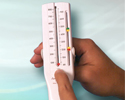Make peak flow a habit!
Asthma - make peak flow a habit; Reactive airway disease - peak flow; Bronchial asthma - peak flow
Checking your peak flow is one of the best ways to control your asthma and to keep it from getting worse.
Checking your peak flow
Peak flow meter - how to use; Asthma - peak flow meter; Reactive airway disease - peak flow meter; Bronchial asthma - peak flow meter
Asthma
Asthma is a disease that causes the airways of the lungs to swell and narrow. It leads to wheezing, shortness of breath, chest tightness, and coughi...
Asthma attacks do not usually come on without warning. Most times, they build slowly. Checking your peak flow can tell you if an attack is coming, sometimes before you have any symptoms.
Asthma attacks
Asthma attack - signs of; Reactive airway disease - asthma attack; Bronchial asthma - attack
What is Peak Flow?
Peak flow can tell you how well you blow air out of your lungs. If your airways are narrowed and blocked due to asthma, your peak flow values drop.
You can check your peak flow at home with a small, plastic meter. Some meters have tabs on the side that you can adjust to match your action plan zones (green, yellow, red). If your meter does not have these, you can mark them with colored tape or a marker.
Write Down Your Peak Flow Numbers
Write down your peak flow scores (numbers) on a chart or diary. Many brands of peak flow meters come with charts. Make a copy of your chart to bring with you when you see your health care provider.
Next to your peak flow number also write:
- Any signs or symptoms you felt.
- Steps you took if you had symptoms or your peak flow dropped.
- Changes in your asthma drugs.
- Any asthma triggers you were exposed to.
Use Your Peak Flow Meter Every Day
Once you know your personal best, take your peak flow at:
- Every morning when you wake up, before you take medicine. Make this part of your daily morning routine.
- When you have asthma symptoms or an attack.
- Again after you take medicine for the attack. This can tell you how bad your asthma attack is and if your medicine is working.
- Any other time your provider tells you to.
Check to see which zone your peak flow number is in. Do what your provider told you to do when you are in that zone. This information should be in your action plan.
Do your peak flow 3 times and record the best value every time you check it.
If you use more than one peak flow meter (such as one at home and another one at school or work), be sure that all of them are the same brand.
References
Durrani SR, Busse WW. Management of asthma in adolescents and adults. In: Adkinson NF Jr, Bochner BS, Burks AW, et al, eds. Middleton's Allergy Principles and Practice . 8th ed. Philadelphia, PA: Elsevier Saunders; 2014:chap 55.
National Asthma Education and Prevention Program. How to use a peak flow meter. How to use a metered-dose inhaler. Last revised March 2013. www.nhlbi.nih.gov/health/public/lung/asthma/asthma_tipsheets.pdf . Accessed March 14, 2016.
Sveum R, Bergstrom J, Brottman G, et al. Institute for Clinical Systems Improvement. Diagnosis and management of asthma. Updated July 2012. www.icsi.org/_asset/rsjvnd/Asthma-Interactive0712.pdf . Accessed April 11, 2016.
Review Date: 2/15/2016
Reviewed By: Neil K. Kaneshiro, MD, MHA, Clinical Assistant Professor of Pediatrics, University of Washington School of Medicine, Seattle, WA. Also reviewed by David Zieve, MD, MHA, Isla Ogilvie, PhD, and the A.D.A.M. Editorial team.

